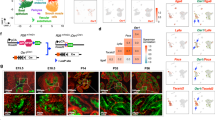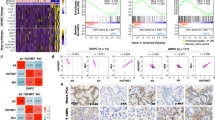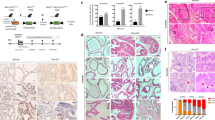Abstract
The majority of prostate epithelial cell lines stably expressing wild-type (wt) or mutant (mt) androgen receptor (AR) are derived from metastatic prostate cancers. Therefore, the wt AR-expressing RC-165N/human telomerase reverse transcriptase (hTERT) cell line derived from the benign prostate tissue of an African-American patient provides a unique opportunity to assess the functional status of AR in a cellular context not studied before. Although androgen-induced expression of known androgen responsive genes such as PMEPA1, and NDRG1 was observed in RC-165N/hTERT, this cell line expresses prostate-specific antigen (PSA) at significantly lower levels. Chromatin immunoprecipitation assay revealed androgen-dependent binding of AR to androgen response elements of PSA, PMEPA1 and NDRG1 genes. Similarities, as well as differences were noted in the expression of androgen responsive genes between RC-165N/hTERT and LNCaP cells. Comprehensive evaluations of AR functions in RC-165N/hTERT cells suggest that whereas some features of known AR functions are maintained in this benign prostatic tissue-derived cell line, other AR functions are not retained. Objective evaluations of similar cell lines will lead to the understanding of AR functions in prostate growth and differentiation.
This is a preview of subscription content, access via your institution
Access options
Subscribe to this journal
Receive 4 print issues and online access
$259.00 per year
only $64.75 per issue
Buy this article
- Purchase on Springer Link
- Instant access to full article PDF
Prices may be subject to local taxes which are calculated during checkout




Similar content being viewed by others
Accession codes
Accessions
GenBank/EMBL/DDBJ
References
Jemal A, Siegel R, Ward E, Murray T, Xu J, Smigal C et al. Cancer statistics, 2006. CA Cancer J Clin 2006; 56: 106–130.
Gu Y, Kim KH, Ko D, Srivastava S, Moul JW, McLeod DG et al. Androgen and androgen receptor antagonist responsive primary African-American benign prostate epithelial cell line. Anticancer Res 2005; 25: 1–8.
Gu Y, Li H, Miki J, Kim KH, Furusato B, Sesterhenn IA et al. Phenotypic characterization of telomerase-immortalized primary non-malignant and malignant tumor-derived human prostate epithelial cell lines. Exp Cell Res 2006; 312: 831–843.
Koochekpour S, Maresh GA, Katner A, Parker-Johnson K, Lee TJ, Hebert FE et al. Establishment and characterization of a primary androgen-responsive African-American prostate cancer cell line, E006AA. Prostate 2004; 60: 141–152.
Sobel RE, Sadar MD . Cell lines used in prostate cancer research: a compendium of old and new lines – part 2. J Urol 2005; 173: 360–372.
Sobel RE, Sadar MD . Cell lines used in prostate cancer research: a compendium of old and new lines – part 1. J Urol 2005; 173: 342–359.
Jemal A, Murray T, Ward E, Samuels A, Tiwari RC, Ghafoor A et al. Cancer statistics, 2005. CA Cancer J Clin 2005; 55: 10–30.
Navone NM, Olive M, Ozen M, Davis R, Troncoso P, Tu SM et al. Establishment of two human prostate cancer cell lines derived from a single bone metastasis. Clin Cancer Res 1997; 3: 2493–2500.
Drukier AK, Ossetrova N, Schors E, Brown LR, Tomaszewski J, Sainsbury R et al. Ultra-sensitive immunoassays using multi-photon-detection in diagnostic proteomics of blood. J Proteome Res 2005; 4: 2375–2378.
Kleiner O, Price DA, Ossetrova N, Osetrov S, Volkovitsky P, Drukier AK et al. Ultra-high sensitivity multi-photon detection imaging in proteomics analyses. Proteomics 2005; 5: 2322–2330.
Agalioti T, Lomvardas S, Parekh B, Yie J, Maniatis T, Thanos D . Ordered recruitment of chromatin modifying and general transcription factors to the IFN-beta promoter. Cell 2000; 103: 667–678.
Masuda K, Werner T, Maheshwari S, Frisch M, Oh S, Petrovics G et al. Androgen receptor binding sites identified by a GREF_GATA Model. J Mol Biol 2005; 353: 763–771.
Orlando V . Mapping chromosomal proteins in vivo by formaldehyde-crosslinked-chromatin immunoprecipitation. Trends Biochem Sci 2000; 25: 99–104.
Rozen S, Skaletsky HJ . Primer3 on the WWW for general users and for biologist programmers. In: Krawetz S, Misener S (eds). Bioinformatics Methods and Protocols: Methods in Molecular Biology. Humana Press: Totowa, NJ, 2000, pp 365–386.
Petrovics G, Liu A, Shaheduzzaman S, Furasato B, Sun C, Chen Y et al. Frequent overexpression of ETS-related gene-1 (ERG1) in prostate cancer transcriptome. Oncogene 2005; 24: 3847–3852.
Segawa T, Nau ME, Xu LL, Chilukuri RN, Makarem M, Zhang W et al. Androgen-induced expression of endoplasmic reticulum (ER) stress response genes in prostate cancer cells. Oncogene 2002; 21: 8749–8758.
Israeli RS, Powell CT, Corr JG, Fair WR, Heston WD . Expression of the prostate-specific membrane antigen. Cancer Res 1994; 54: 1807–1811.
Ulrix W, Swinnen JV, Heyns W, Verhoeven G . The differentiation-related gene 1, Drg1, is markedly upregulated by androgens in LNCaP prostatic adenocarcinoma cells. FEBS Lett 1999; 455: 23–26.
Gao N, Zhang J, Rao MA, Case TC, Mirosevich J, Wang Y et al. The role of hepatocyte nuclear factor-3 alpha (Forkhead Box A1) and androgen receptor in transcriptional regulation of prostatic genes. Mol Endocrinol 2003; 17: 1484–1507.
Levedakou EN, Strohmeyer TG, Effert PJ, Liu ET . Expression of the matrix Gla protein in urogenital malignancies. Int J Cancer 1992; 52: 534–537.
Konduri SD, Tasiou A, Chandrasekar N, Rao JS . Overexpression of tissue factor pathway inhibitor-2 (TFPI-2), decreases the invasiveness of prostate cancer cells in vitro. Int J Oncol 2001; 18: 127–131.
Chen C, Lewis SK, Voigt L, Fitzpatrick A, Plymate SR, Weiss NS . Prostate carcinoma incidence in relation to prediagnostic circulating levels of insulin-like growth factor I, insulin-like growth factor binding protein 3, and insulin. Cancer 2005; 103: 76–84.
Lopez JB, Sahabudin RM, Chin LP . Are plasma insulin-like growth factor I (IGF-I) and IGF-binding protein 3 (IGFBP-3) useful markers of prostate cancer? Int J Biol Markers 2004; 19: 164–167.
Miyata Y, Sakai H, Kanda S, Igawa T, Hayashi T, Kanetake H . Expression of insulin-like growth factor binding protein-3 before and after neoadjuvant hormonal therapy in human prostate cancer tissues: correlation with histopathologic effects and biochemical recurrence. Urology 2004; 63: 1184–1190.
Li H, Kantoff PW, Giovannucci E, Leitzmann MF, Gaziano JM, Stampfer MJ et al. Manganese superoxide dismutase polymorphism, prediagnostic antioxidant status, and risk of clinical significant prostate cancer. Cancer Res 2005; 65: 2498–2504.
Venkataraman S, Jiang X, Weydert C, Zhang Y, Zhang HJ, Goswami PC et al. Manganese superoxide dismutase overexpression inhibits the growth of androgen-independent prostate cancer cells. Oncogene 2005; 24: 77–89.
Cao J, Chiarelli C, Kozarekar P, Adler HL . Membrane type 1-matrix metalloproteinase promotes human prostate cancer invasion and metastasis. Thromb Haemost 2005; 93: 770–778.
Culig Z, Klocker H, Bartsch G, Steiner H, Hobisch A . Androgen receptors in prostate cancer. J Urol 2003; 170: 1363–1369.
Isaacs JT, Isaacs WB . Androgen receptor outwits prostate cancer drugs. Nat Med 2004; 10: 26–27.
Pinter O, Pajor L, Molnar J, Marki A, Falkay G . The role of androgen receptors in the dynamic process of prostate cancer: their analytical determination in biopsy material. In Vivo 2004; 18: 809–812.
Lee C, Sutkowski DM, Sensibar JA, Zelner D, Kim I, Amsel I et al. Regulation of proliferation and production of prostate-specific antigen in androgen-sensitive prostatic cancer cells LNCaP, by dihydrotestosterone. Endocrinology 1995; 136: 796–803.
Wright Jr GL, Grob BM, Haley C, Grossman K, Newhall K, Petrylak D et al. Upregulation of prostate-specific membrane antigen after androgen-deprivation therapy. Urology 1996; 48: 326–334.
Asatiani E, Huang WX, Wang A, Rodriguez Ortner E, Cavalli LR, Haddad BR et al. Deletion, methylation, and expression of the NKX3.1 suppressor gene in primary human prostate cancer. Cancer Res 2005; 65: 1164–1173.
Bowen C, Bubendorf L, Voeller HJ, Slack R, Willi N, Sauter G et al. Loss of NKX3.1 expression in human prostate cancers correlates with tumor progression. Cancer Res 2000; 60: 6111–6115.
He WW, Sciavolino PJ, Wing J, Augustus M, Hudson P, Meissner PS et al. A novel human prostate-specific, androgen-regulated homeobox gene (NKX3.1) that maps to 8p21, a region frequently deleted in prostate cancer. Genomics 1997; 43: 69–77.
Steadman DJ, Giuffrida D, Gelmann EP . DNA-binding sequence of the human prostate-specific homeodomain protein NKX3.1. Nucleic Acids Res 2000; 28: 2389–2395.
Martin JL, Pattison SL . Insulin-like growth factor binding protein-3 is regulated by dihydrotestosterone and stimulates deoxyribonucleic acid synthesis and cell proliferation in LNCaP prostate carcinoma cells. Endocrinology 2000; 141: 2401–2409.
Meehan KL, Sadar MD . Quantitative profiling of LNCaP prostate cancer cells using isotope-coded affinity tags and mass spectrometry. Proteomics 2004; 4: 1116–1134.
Xu LL, Su YP, Labiche R, Segawa T, Shanmugam N, McLeod DG et al. Quantitative expression profile of androgen-regulated genes in prostate cancer cells and identification of prostate-specific genes. Int J Cancer 2001; 92: 322–328.
Sun C, Shi Y, Xu LL, Nageswararao C, Davis LD, Segawa T et al. Androgen receptor mutation (T877A) promotes prostate cancer cell growth and cell survival. Oncogene 2006; 25: 3905–3913.
Swinnen JV, Heemers H, van de Sande T, de Schrijver E, Brusselmans K, Heyns W et al. Androgens, lipogenesis and prostate cancer. J Steroid Biochem Mol Biol 2004; 92: 273–279.
Wallace HM, Fraser AV . Inhibitors of polyamine metabolism: review article. Amino Acids 2004; 26: 353–365.
Denmeade SR, Sokoll LJ, Dalrymple S, Rosen DM, Gady AM, Bruzek D et al. Dissociation between androgen responsiveness for malignant growth vs expression of prostate specific differentiation markers PSA, hK2, and PSMA in human prostate cancer models. Prostate 2003; 54: 249–257.
Acknowledgements
We are thankful for the generous support of Dr David G McLeod, Director of the Center for Prostate Disease Research. We acknowledge the excellent technical support of Ms Soyon Oh and Ms Jennifer Regalia. Also, we are thankful for Dr Ossetrova from BioTraces Inc. for performing PSA detection with the Super-ELISA system. This research was supported by the Center for Prostate Disease Research Program through the Henry M Jackson Foundation for the Advancement of Military Medicine under contract number HU001-04-C-1502 (2004) with the Uniformed Services University. The opinions and assertions contained herein are the private views of the authors and are not to be considered as reflecting the views of the Henry M Jackson Foundation for the Advancement of Military Medicine or the US Department of Defense.
Author information
Authors and Affiliations
Corresponding authors
Rights and permissions
About this article
Cite this article
Kim, KH., Dobi, A., Shaheduzzaman, S. et al. Characterization of the androgen receptor in a benign prostate tissue-derived human prostate epithelial cell line: RC-165N/human telomerase reverse transcriptase. Prostate Cancer Prostatic Dis 10, 30–38 (2007). https://doi.org/10.1038/sj.pcan.4500915
Received:
Revised:
Accepted:
Published:
Issue Date:
DOI: https://doi.org/10.1038/sj.pcan.4500915
Keywords
This article is cited by
-
The DNA/RNA helicase DHX9 contributes to the transcriptional program of the androgen receptor in prostate cancer
Journal of Experimental & Clinical Cancer Research (2022)
-
Proteomic characterization of paired non-malignant and malignant African-American prostate epithelial cell lines distinguishes them by structural proteins
BMC Cancer (2017)
-
Identification of novel androgen-responsive genes by sequencing of LongSAGE libraries
BMC Genomics (2009)
-
Ndrg1
AfCS-Nature Molecule Pages (2008)



